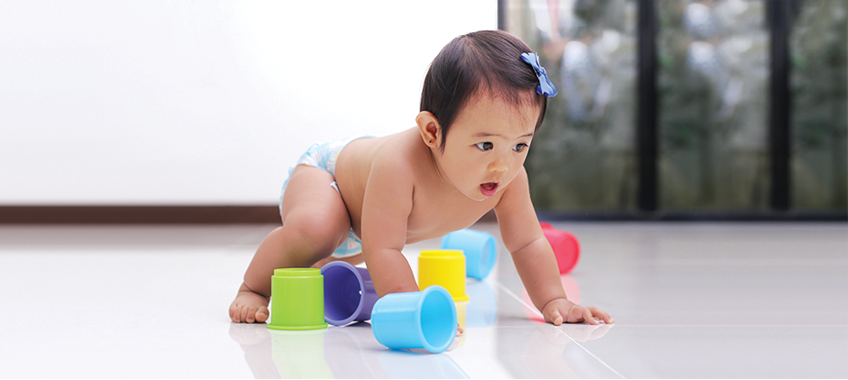Five Activities to Develop Your Baby’s Gross Motor Skills
Are you wondering if your baby is developing naturally? Like adults, babies are unique and different, growing and developing at their own pace. However, that doesn’t mean that you can’t help your infant develop these skills faster.
During the first few months of your baby’s birth, you notice a slow and steady transition from odd and jerky to stronger, more deliberate movements, as they start to gain control over their fine and gross motor skills. The Baby Center expounds on the difference: “Fine motor skills are small movements — such as picking up small objects and holding a spoon — that use the small muscles of the fingers, toes, wrists, lips, and tongue. Gross motor skills are the bigger movements — such as rolling over and sitting — that use the large muscles in the arms, legs, torso, and feet.” Therefore, gross motor skills, which develop before the fine motor skills, are the larger movements your baby makes. The development of these skills results in your baby’s ability to sit, balance, crawl, walk, run, and so on.
That said, here are five activities you can do to enhance your baby’s gross motor skills:
- Place baby in different positions
Your baby won’t be able to do much on their own for the first three months, but one thing you can do is to introduce them to different movements. While on their back, gently flex their legs to mimic bicycle movements. This familiarizes their muscles with the motion and movement.
Another thing you can do is to place your baby in different positions. For example, babies can lift their heads for brief periods of time when on their tummy. Place your baby on their belly regularly to exercise their back and neck muscles. Whether it’s from the crib to the floor or from tummy to back, placing them in different positions stimulates different muscles, causing them to adjust and perform different motions. For instance, babies tend to push-up while on their tummies.
- Place toys just out of reach
At three to six months, your baby should be able to roll over and sit with support. One way to encourage them to move in a specific direction is to place them on their belly and help them reach a toy that’s just out of reach. This encourages them to move towards something instead of remaining in place.
Also, at six to nine months, once their legs are strong enough, place a toy on a couch, chair, or low table to encourage them to stand to reach for it.
- Create an obstacle course
At six to nine months, your baby should begin to crawl. Encourage this newfound mobility in a fun way by creating a simple and safe obstacle course using cushions, pillows, and blankets.
A simpler option would be to place interesting objects in and around safe spaces for them to discover. Put these objects at various heights and levels so there’s always something new to see, whether they’re crawling, sitting, or standing.
- Blow bubbles for them
Bubbles encourage curiosity! You can entice your little one to go after them and reach up on their tippy toes to pop them. This is great for developing leg muscles as well as hand-eye coordination. It’s also a lot of fun for both of you!
- Play ball
At one to two years, your baby should have enough mobility to pull and push things from a standing position, walk up and down stairs with your aid, and even kick a ball, to name a few things.
You can start by rolling a large, soft ball to them. Initially, they might just slap it, but eventually they’ll learn to pass the ball back in your direction.
Finally, when your baby is up and about, play football with them. This is a great activity as kicking requires babies to support their weight with one foot as the other foot goes for the ball.
For more information and EQ support, feel free to ask our experts here.
Sources:
http://day2dayparenting.com/how-children-develop/gross-motor-skills-infants-toddlers-children/

